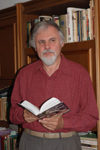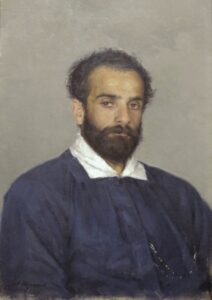
By Alex Gordon


HAIFA, Israel — Isaac Levitan, founder of the genre of the “mood landscape,” is one of the greatest artists of Russia. He was born in a shtetl of Kibarty, a part of the Russian Empire (present-day Lithuania), into a poor but educated Jewish family of a railroad clerk. His father Elyashiv, the son of a rabbi, learned French and German upon graduation from the Vilna rabbinical school and earned money by private lessons in Moscow, to which he brought the family in 1870.
In 1873 Isaac entered the Moscow School of Painting, Sculpture and Architecture, where his brother Adolf (Abel Leib) studied. After the death of their mother (1875) and father (1877), the brothers and their two sisters were left homeless. Levitan often slept secretly in the school and lived on a starvation diet, receiving occasional allowances, and since October 1879 – a small stipend.
After the unsuccessful attempt on the life of Tsar Alexander II by the Russian terrorist Alexander Soloviev in April 1879, Jews who had nothing to do with this terrorist act were evicted from large cities en masse. Because of the eviction of Jews from Moscow, Levitan was forced to live in the suburbs (the village of Saltykovka), where he painted Autumn Day. Sokolniki, soon acquired by Pavel Tretyakov for his gallery. It was his first painting and the only landscape with a human being present, and the female figure was painted by his fellow student, the brother of the writer Anton Chekhov, Nikolai. After this painting, people never appeared on his canvases.
Levitan was highly appreciated by his teachers, the famous painters Alexei Savrasov and Vasily Polenov. Isaac painted a landscape as a graduate thesis. Savrasov recommended to give his diploma the “Big Silver Medal.” But, according to the teachers, a Jew should not paint a Russian landscape – this is the business of native Russian artists. The painting was deemed unworthy of a medal. Levitan did not even receive the title of artist, he was given a diploma of a teacher of drawing (1884).
“Ahasverus (The Wandering Jew) curse gravitates and over me, but it must be so – I am also a Semite.” – Levitan wrote to Chekhov, when in 1892 he and other Jews were evicted from Moscow for the second time, although he was already a celebrated artist. Levitan again felt the commonality of fate with his people.
The artist was poor for many years and until the end of his life did not have his own home. The feeling of homelessness was aggravated in Levitan’s difficulties to win recognition. Many famous artists painted landscapes, Savrasov, Polenov, Ivan Shishkin and Arkhip Kuindzhi. To gain recognition, Levitan had to find his niche in the field of landscape. The shelterless Jew was looking for his place in the Russian landscape. Most of all he was attracted to the fall. Levitan created about a hundred “autumn” paintings and finally created the genre of “mood landscape,” which served to express complex reflections on life. He found his niche in this “mood landscape,” which with all the natural authenticity radiated psychological intensity. Despite the absence of human figures and portraits in his paintings, his painting depicted the life of the human soul, which seems to gaze into nature.
In the essay On the death of Alexei Savrasov (1897) Levitan so formulated his creative credo: the refusal to treat the landscape “as a beautiful combination of lines and objects” in order to depict “no longer exclusively beautiful places” but “those intimate, deeply touching, often sad features that are so strongly felt in our native landscape and so irresistibly affect the soul.”
Levitan’s ar, turning the landscape into an image of nature in Russia, reached its peak in the paintings Birch Forest (1885 -1889), Evening on the Volga (1888), Evening. Golden Plyos (1889) and ”Fresh Wind. Volga” (1891-1895). Levitan created classic examples of the ecclesiastical landscape, where the buildings of churches bring peace to nature, as in the painting Evening Bell (1892).
One of the important pages of Levitan’s biography is his friendship with the writer Anton Chekhov. Having made friends with the artist Nikolai Chekhov, the brother of the writer, Levitan then became friends with Anton and with all the talented and cheerful Chekhov family. The Chekhovs especially teased Levitan for his handsome Jewish face – Anton often remarked on Levitan’s beauty: “I will come to you, handsome as Levitan.” Chekhov cruelly mocked Levitan and his beloved artist Sophia Kuvshinnikova, depicting them in a caricatured form in the story “The Grasshopper.” Their friendship had ceased.
Levitan’s work played a major role in his tendency to bouts of black melancholy. He acutely experienced ill health (he had a congenital heart defect), and all the drama of the situation of the Jews in Russia. Because of the constant longing in his paintings, joyful play of light and color can rarely be found.
In the painting Above Eternal Rest (1893 – 1894) Levitan with great force expressed the poetry of an inclement day. None of the artists before Levitan conveyed with such a sad force Russian inclement weather and human longing. Lev Tolstoy called this painting “a prayer of the mute soul. In one of his letters Levitan wrote about this painting: “Eternity, a formidable eternity, in which sank generations and will sink yet. […] What horror, what fear! […] I am all in it, with all my psyche, with all my content.”
Levitan was not married, he had no children. He was often joyless, as joyless was the history of his people. Bitter thoughts about the Jewish people caused him bouts of painful depression – moping, intensified by dissatisfaction with his work. During the moping Levitan fled from people who seemed to be his enemies, from whom he went into the forests, and wandered in them for a long time.
Levitan reluctantly traveled abroad on the advice of doctors. He visited Italy, France, Switzerland and Finland (1890s). But the nature of these countries made Levitan sad. “Once again I moped without measure and boundaries,” wrote Levitan to Chekhov from Finland. “There is no nature here.” In Paris, Levitan saw the paintings of Claude Monet, but did not remember them. Only before his death, he appreciated the painting of the Impressionists and realized that he himself was partly their Russian predecessor, and for the first time with recognition mentioned their names.
For a while the impoverished Levitan lived in Moscow in furnished rooms. He paid for his room with sketches. The landlady did not like his landscapes. She wanted to see a thoroughbred cow in the meadow, and under a tree, a pair of sitting lovers. Some critics also demanded that the artist enliven the landscape with geese, horses, figures of shepherds and women.
In March 1898 Levitan received the title of academician of painting and began teaching at the very school where he studied himself. He dreamed of creating a House of Landscapes – a large studio in which all Russian landscape painters could work. In his landscape studio almost half of the large room was given over to a corner of the forest, in which there were spruces, small trees with yellow leaves, green moss, turf, tubs of ferns. The light from the window fell as it would in a forest glade. Often Levitan brought flowers to the studio. He told his students that flowers should be painted so that they smell not of paint, but of flowers.
Levitan’s severe heart disease progressed. More and more often he went into the woods, and there he was found crying and confused. He knew that neither doctors, nor his favorite nature, could no longer distance the approaching end.
In the winter of 1899 doctors sent Levitan to Yalta. Chekhov was living there at the time. Levitan walked, leaning heavily on a stick, panting and talking about near death. Yalta did not help. Levitan returned to Moscow and almost never left his house. On August 4, 1900, he died.
In 1949, during the anti-Semitic campaign against “cosmopolitans,” that is, Jewish literary and artistic figures, the journal Iskusstvo (Art), No. 5, declared that Levitan’s work leads to “dangerous labyrinths of individualism.” The Stalinist system feared that a Jew who had died half a century before would be considered a Russian artist.
*
Alex Gordon is professor emeritus of physics at the University of Haifa and at Oranim, the Academic College of Education, and the author of 11 books.